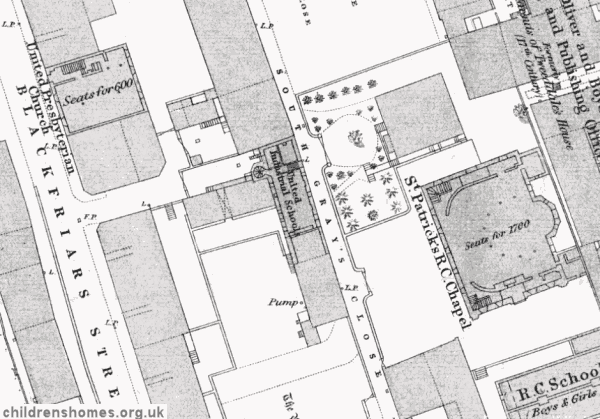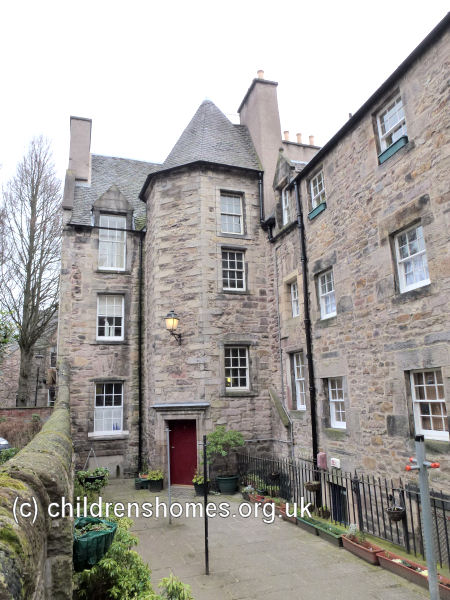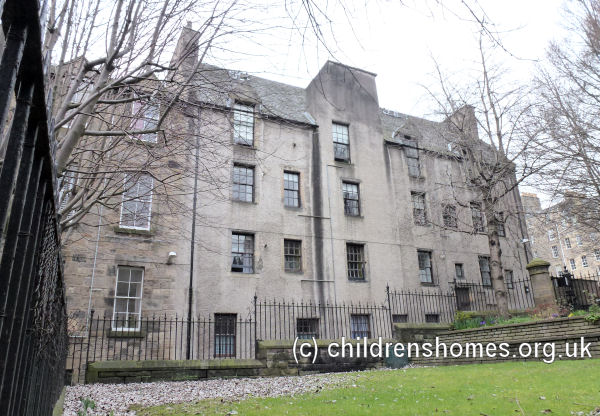United Industrial School, Edinburgh, Midlothian, Scotland
In 1847, Dr Thomas Guthrie launched a scheme in Edinburgh to open Ragged Industrial Schools for poor boys and girls in the city. Although his establishments attracted much support, the religious education they provided were viewed by some as discriminating against Roman Catholics. As a result, a new school was founded which, unusually, would be open to children of all denominations, but would always include a Catholic teacher on its staff to conduct religious lessons and observances for the Catholic children. The school occupied a seventeenth century building known as Skinner's Hall, on South Gray's Close, a narrow lane running between the High Street and Cowgate. The official opening ceremony, presided over by Lord Dunfermline, took place on 30 November. The school's first superintendent was Mr Maxwell.
The school could accommodate about 200 pupils. In February 1848, it was reported that there had been around 1500 applications for places at the school, of which 1300 had to be turned away.
At the end of 1848, a meeting of the school's friends and subscribers were told that the boys were taught tailoring, shoemaking and carpentry, and the girls knitting, sewing and such household duties that would qualify them for domestic servants. Between 10 and 11 each morning, the Protestant pupils received religious instruction from the head teacher, with the Tron Church being used for worship. At the same hour, in a separate classroom, the Catholic children received instruction, using the Douay translation of Scripture, from the assistant teacher, himself a Catholic. On Sundays, they attended a Catholic church and in the evening were visited and instructed by their clergy.
In 1854, Mr Charles Ferguson was appointed superintendent of the school.
On 25 November 1855, the establishment was certified under Dunlop's Act to operate as a Reformatory (later reassigned as an Industrial School), allowing it to receive children placed under detention by magistrates. There was initially little uptake of this facility — in 1862 it was reported that only one child at the school was in this category. By the end of 1865, however, of the school's average daily attendance of 139 boys and 35 girls, 78 of the boys and 17 of the girls were under detention. At this date, a little over half of the pupils were Roman Catholic.
1861, the then novel facilities of a bathroom and lavatory were erected at the school to improve the health and cleanliness of the pupils. In the same year, Miss McLaren was appointed as matron of the establishment.
An inspection in 1863 suggested that that the school's location inevitably resulted in a shortage of space for play and airing, this deficiency was considerably counterbalanced by the ready access it provided for the class of children for which it was intended. Many of these were said to be very young and very ignorant, having in most cases learned little more than their letters before entering the school. The boys' industrial training at that date comprised tailoring, shoemaking, brush making, woodcutting, turning and carpentry. The girls learned needlework and carried out the washing and housework of the school.
Major building work began at the site in 1863. Some tumbledown workshops at the west of the site, opening into Toddrick's Wynd, had been demolished. In their place was a large new block containing four workshops and two large dormitories. To save money, the plans for the construction were drawn up by the superintendent, Mr Ferguson, and boys from the school undertook all the joinery involved as well as contributing to the building work wherever possible. The expenditure involved for new building was only £380, compared to a builder's estimate of £600 for the job. Following the work, the school's main entrance was relocated and its address became 31 Blackfriars Street. Further alterations in 1870 included a substantial new building on the east of the site providing new workshops and school rooms.
The school site, following construction of the new additions, is shown on the 1877 map below.

United Industrial School site, Edinburgh, c.1877.

United Industrial School, Edinburgh, c.1882. © Peter Higginbotham

Former United Industrial School from the west, Edinburgh, 2013. © Peter Higginbotham

Former United Industrial School from the west, Edinburgh, 2013. © Peter Higginbotham

Former United Industrial School from the east, Edinburgh, 2013. © Peter Higginbotham
In 1870, Mr Archibald Lauchlan succeeded Mr Ferguson as superintendent. Unusually, no living accommodation was provided for the post. In 1872, Mrs McGregor replaced Mrs Smith as matron, which was a resident position.
In 1879, following a decline in the number of girls being placed at the school, it became a boys-only establishment.
Further alterations in 1883 created a new committee room, office, sick room, show room, swimming bath, and tailor's and shoemaker's shops placed over a large play-shed.
In 1887, the boys were taken to Elie on the coast of Fife for a fortnight, taking down their own beds and cooking equipment. The school now had a brass band of 25 boys, and a drum and fife band of 18.
On 13 June 1891, a house at 52 Lauriston Place, Edinburgh, was certified for use as an Auxiliary Home for the accommodation of up to 25 boys on licence from the school. The boys were engaged during the day in various places of occupation in the city. The home was managed by the superintendent and his wife, Mr and Mrs Donoghue, under the direction of a local comnmittee. A schoolmaster attended in the evening to give the boys the opportunity of keeping up their school knowledge.
Despite receiving generally positive reports, the school's location in a slum district, and its being overlook by a tall neighbouring tenement, were regularly raised as concerns by inspectors. In 1900, the school's managers decided to close the establishment. The premises were later occupied by St Anne's Catholic School but were converted to residential use in 1981.
Records
Note: many repositories impose a closure period of up to 100 years for records identifying individuals. Before travelling a long distance, always check that the records you want to consult will be available.
- National Records of Scotland, HM General Register House, 2 Princes Street, Edinburgh EH1 3YY. Holding comprise Discharge register (1879-87); Unspecified records (1896-98).
Census
Bibliography
- Higginbotham, Peter Children's Homes: A History of Institutional Care for Britain's Young (2017, Pen & Sword)
- Mahood, Linda Policing Gender, Class and Family: Britain, 1850-1940 (1995, Univeristy of Alberta Press)
- Prahms, Wendy Newcastle Ragged and Industrial School (2006, The History Press)
Links
- None noted at present.
Except where indicated, this page () © Peter Higginbotham. Contents may not be reproduced without permission.


